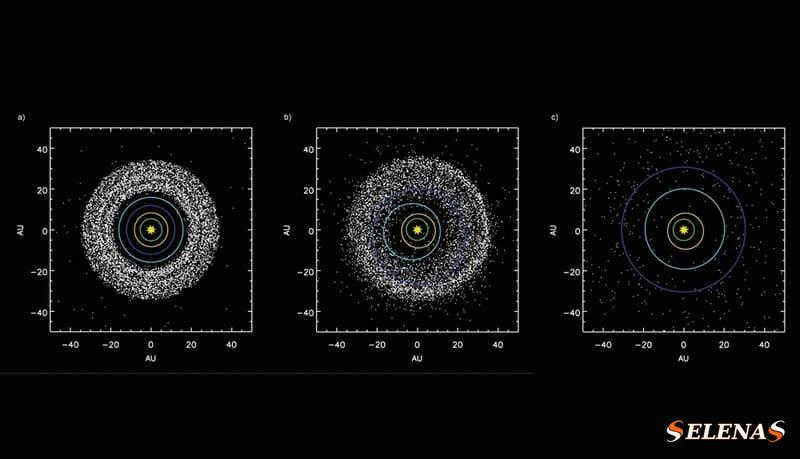The solar system is a captivating ensemble, comprised of a central star, the Sun, as well as eight orbiting planets, their satellites, numerous celestial bodies, and the interplanetary medium.
This extraordinary arrangement took approximately 4.6 billion years to fully evolve. Throughout history, various scientists, including German philosopher Kant, French physicist Laplace, and English astronomer Fred Hoyle, have proposed intriguing hypotheses regarding the formation of the solar system, each offering distinct assumptions.
However, it was the perspective of Russian mathematician Otto Yulevich Schmidt that laid the foundation for the modern theory. Schmidt’s viewpoint suggests that the Sun and its surrounding celestial bodies originated from a cold gas-dust cloud, which experienced a profound gravitational compression, resulting in their formation.
If we summarize the general process in a concise manner, it can be described as follows: the rotating cloud gradually accelerated, causing the center to heat up and shrink in size. This eventually led to the formation of a hot protostar, which would go on to become our Sun. Simultaneously, protoplanetary disks formed on the outer edges of the cloud, gradually accumulating mass and transforming into planets over time.
The Birth of the Sun
The gas-dust cloud underwent a remarkable transformation due to a powerful surge of energy. Scientists hypothesize that this surge was caused by a shockwave resulting from the explosion of a supernova star. This shockwave caused an instantaneous compression of mass, leading to the formation of a dense and hot core at the center of the cloud. The remaining mass dispersed to the outer regions, shaping a vast disk.
As time passed, the core experienced a rise in temperature, pressure, and density, ultimately evolving into a protostar. Once critical thresholds of temperature and pressure were reached, thermonuclear reactions commenced within the core, causing hydrogen to convert into helium. Thus, the protostar ceased to exist, giving rise to a star that we now know as the Sun.
In the field of astronomy, there exists a mathematical theory which posits that the transition from cloud formation to the commencement of thermonuclear reactions took approximately 100,000 years.
The Birth of Planets
The solar system’s eight planets are classified into two distinct categories: terrestrial and gas giant.
The gas giant category consists of:
All planets are believed to have originated during the same time period, yet scientists hold differing opinions on their genesis and composition.
The creation of the terrestrial planets
In certain regions of the disk encircling the Sun, sections of the gas-dust cloud began to compress. Gradually, they transformed into dense rings that attracted solid matter from outer space.
Due to the high temperature within the rings, ice and gas in their original state could not exist. However, the heat-resistant rocks served as an excellent construction material – they are the fundamental components of the Earth-group planets.
Scientists continue to debate the duration of the process of forming the Earth-group planets. Currently, various estimates suggest that it ranged from 10 to 100 million years.
As the masses increased, the disks evolved into the four planets that are now known as Earth, Mars, Venus, and Mercury. This stage marked the initial phase of their development.
The origin of the gas giants
The gas giant planets are situated at a considerable distance from the Sun, resulting in significantly lower temperatures compared to Earth. This unique condition played a crucial role in their formation, as they were able to accumulate mass through gravitational attraction of gas from the surrounding space. This mechanism is known as accretion.
Currently, the gas giants are the largest celestial bodies in our solar system. The following table outlines their key characteristics:
The process of gas accretion spanned over millions of years, concluding when the gas content in the protoplanetary disk reached critically low levels.
Satellite Formation
The subsequent phase in the development of the solar system involved the creation of satellites in close proximity to the planets. Astronomers and physicists have identified three potential mechanisms:
- Capture of a smaller object by a larger object that passes nearby.
- Transformation of the disk surrounding the planet.
- Collision and merging of fragments.
Scientists are still debating the specific processes that led to the formation of each satellite. For instance, the characteristics of the Moon are consistent with any of the three mechanisms.
The region between Mars and Jupiter known as the Asteroid Belt
As depicted in the diagram below, the majority of asteroids are found within the space between the orbits of Mars and Jupiter, forming what is known as the Asteroid Belt.
Those asteroids that are closer to Mars are primarily composed of iron and rocky materials, while those closer to Jupiter contain a significant amount of ice, exhibiting a composition similar to the original gas-dust cloud.
By considering the distance of Mars and Jupiter from the Sun, we can gain a clearer understanding of the composition of asteroids. Temperature also plays a crucial role in this analysis, with the outer regions being colder and containing more gas and ice.

The birth of the solar system has been a longstanding question that space researchers have been seeking to answer. Exploring celestial bodies in this realm enables the formation of fresh and more coherent hypotheses regarding the origins of our star system. The quest for clues drives humanity to enhance research methodologies and broaden horizons in our understanding of the universe.

This article presents the most up-to-date theories on the origin and development of the solar system.
When did it happen?
The nebular model is the most widely accepted hypothesis in the scientific community regarding the formation of the Solar System. According to this model, our star system originated from a cloud of gas and dust.
The nebular hypothesis was initially proposed by the German philosopher Kant in 1755 and has since been tested and refined. Currently, it is supported by the majority of space researchers.
Based on Kant’s theory, the Sun and its orbiting planets were formed from a vast cloud of hydrogen through the intense gravitational compression it exerted. This event occurred approximately 4.6 billion years ago. The process of star formation alone lasted around 10 million years, while the formation of other celestial bodies took several hundred millennia. As a result, structures like the asteroid belt and planetary moons came into existence.
Stages of development
Now let’s examine the key ideas of the nebular hypothesis regarding the formation of the solar system. The initial stage involves the birth of the central star, which emerges from an immense, cold hydrogen cloud. Eventually, due to gravitational forces, the mass of hydrogen starts to rapidly contract, leading to a collapse. As a result, fragments break away from the cloud and go through their own gravitational collapses, ultimately condensing into stars. These individual sections of the cloud are referred to as protostellar nebulae.
The Birth of the Sun
The process of the Sun’s formation starts with the gradual attraction of vast amounts of interstellar dust and gas by the nebula. This accumulation of matter causes the nebula to start its orbital movement. In the central area of this region, the gas starts to compress, giving rise to the radiant core of the future star. As the collapse of the nebula progresses, the protostar’s rotational momentum increases. The gas and dust surrounding the protostar experience a significant acceleration.

Once the protostar has accumulated enough mass through the capture of gas and matter, the process of nuclear fusion begins in its core. To achieve this, the protostar must have a mass 80 times that of Jupiter. The time it takes for the protostar to transition from a nebula to the initiation of nuclear fusion is on average 100,000 years.
At this stage, the new star is still relatively small and classified as a brown dwarf. It continues to gather material from the surrounding nebula and gradually transforms into a star similar to our Sun over the course of several hundred million years.
Genesis of inner-group planets
The genesis of inner-group planets occurred within the regions of the protoplanetary disk where the ambient temperature was too elevated for the existence of ice and gaseous particles in their natural states. As a result, these celestial bodies predominantly consisted of thermally stable rocks. Initially, planetesimals rapidly accumulated mass, expanding to sizes exceeding one kilometer in diameter. Subsequently, larger fragments gravitationally attracted smaller ones until the reservoir of planetesimals in the disk was entirely depleted. The stage of final formation of the Solar System and the establishment of definitive orbits by its celestial bodies was then reached. The entire process of the emergence of the inner-group planets spanned from 10 to 100 million years.

The Birth of Gas Giants
The creation of gas giants is a more intricate process. Prior to the formation of large planetesimals, their development is similar to that of terrestrial planets like Earth. However, gas giants contain ice particles and accumulate mass by capturing gas from the protoplanetary disk. This is made possible by the relatively low temperatures in the outer region of the future star system. The process of gas accumulation takes several million years until the gas reserves of the disk are depleted. The formation of gas giants has a significant impact on the number of rocky planets in the system. The earlier the formation of gas planets commences, the less material will be available for the creation of Earth-like bodies.

The Destiny of the Sun
Our solar system will remain relatively stable until the hydrogen reserves within the core of the Sun are exhausted. As the Sun ages, it will expand rapidly in size and emit increasingly more energy. In one billion years, the Earth’s surface will become so hot that the water in the world’s oceans will completely evaporate. The presence of water vapor clouds will intensify the greenhouse effect, leading to further warming of the planet. In another 2.5 billion years, the Earth will have similar conditions to present-day Venus, while Mars will be much more suitable for supporting life.
In approximately 7 billion years, the sun will deplete all of its hydrogen reserves, leading to the commencement of hydrogen burning from the encompassing envelope. Consequently, the sun will expand and transform into a red giant, ultimately engulfing Mercury, Venus, and Earth in its massive size.
The solar core will rapidly accumulate mass until it initiates a thermonuclear reaction, converting helium into carbon. This phase will endure for several hundred million additional years, after which it will expel vast amounts of stellar material into space, forming a planetary nebula. The remaining celestial bodies will be disrupted from their orbits, undergoing chaotic motion. In approximately 75,000 years, the red giant will complete its transformation into a white dwarf, gradually cooling down and fading away. The surrounding planets will also cool down and perish alongside the central star. According to scientific estimates, the entire lifespan of the solar system, from birth to demise, will span approximately 12.5 billion years.
List of alternative theories
Aside from Kant’s nebular hypothesis, there exist various alternative concepts regarding the origins of the solar system. Some of the most well-known include:
It is common knowledge that the formation of planets is not an instantaneous event, and not every celestial body has the potential to undergo this transformation. In reality, the development of a planet is influenced by numerous factors, and this intricate process spans over countless millions, and even billions, of years.
The creation of the solar system
Based on contemporary perspectives, our stellar system came into existence approximately 4.6 billion years ago. Through the gravitational collapse of a portion of an enormous interstellar molecular cloud, a substantial amount of matter became concentrated at the center of this collapse. This concentration led to the formation of a star known as the Sun. Simultaneously, the remaining matter coalesced into a protoplanetary disk, which revolves around the central star.
In fact, planets, satellites, asteroids, and other celestial bodies were formed from this disk.
Within the solar system, a multitude of interactions take place, ranging from minuscule particles to massive objects. In essence, they shift, collide, merge, and disintegrate while giving rise to novel entities. One could argue that there is an ongoing, perpetual development and evolution of the entire Universe.
For instance, not only do the size and distinctive traits of objects transform, but the boundaries and constituents of the entire system as well.
The origins of planets
In the beginning, protoplanets were formed in the system, specifically as large embryos in the protoplanetary disk, where internal melting had already occurred and the process of formation and separation of the interior had commenced.
Subsequently, their sizes underwent alterations, either increasing or decreasing, as a result of mergers and collisions with one another. For instance, Mercury lost a portion of its mantle during a collision with another celestial body. Interestingly, the Moon is believed to have formed from a massive collision.
At present, we are witnessing the outcome of interactions, so to speak, clashings of celestial objects.
It remains somewhat inexplicable how the initial orbits of protoplanets led to the creation of nearly circular planetary orbits.
However, it is certain that the Sun, with its energy and heat, played a role in the very formation of planets around it, as well as their fundamental characteristics (composition, size, temperature, etc.).
Planet formation, in fact, initiates through specific evolutionary processes:
- An embryo emerges within a gas disk encircling the newly formed star and rotating in a circular motion;
- The gravitational force of matter causes the embryo to accumulate mass through accretion;
- A celestial body takes shape in the stellar orbit, attracting gas and dust particles from the disk, gradually becoming enriched with heavy chemical elements.
Subsequently, the compression and formation of the planets’ core, interior, and outer shell commences.
In simpler terms, minuscule particles come together to form colossal planet-like entities. If they have managed to attract a significant amount of gas, a gas giant is formed. Conversely, if there is a scarcity of gas, Earth-like planets (including our own) eventually arise.
While there is an alternative theory regarding the origin of planets, suggesting that they form through the collapse of an initial gas-dust cloud, there is considerable controversy surrounding it within the scientific community. This is primarily due to the existence of a “gap” between large planets and small stars, making it unlikely for planets to have descended from their stellar counterparts.
As we are aware, stars are distinguished by their significant mass, size, and the occurrence of thermonuclear reactions within them. If celestial bodies do not possess sufficient mass, these reactions will not take place. Consequently, it is possible for planets to be formed from such objects, albeit under the influence of other determining factors.
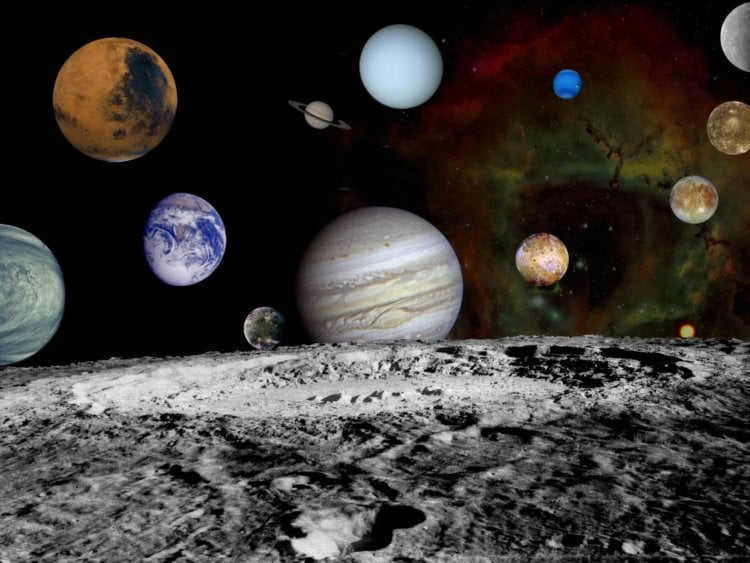
There are various theories that can provide an answer to this question.
When considering the formation of the Solar System, the most popular and widely acknowledged viewpoint is the nebular hypothesis. This model suggests that billions of years ago, the Sun, planets, and other celestial bodies in the solar system originated from dense clouds of molecular hydrogen. Initially proposed as an explanation for the formation of the solar system, it continues to be the most widely accepted theory.
What is the nebular hypothesis?
The nebular hypothesis suggests that our solar system, including the Sun and all the planets, originated from a massive cloud of gas and dust. This cloud collapsed approximately 4.47 billion years ago, possibly due to the influence of a passing star or supernova explosions, although the exact cause remains unknown. The collapse resulted in a gravitational collapse at the center of the cloud.
Following the collapse, denser regions of gas and dust within the cloud began to form. As these regions reached a certain density, they started rotating in accordance with the law of conservation of momentum and became heated due to increased pressure. The majority of the material gathered in the central region, while the remaining matter formed a ring around this central region.
The Sun eventually formed from the clot at the center, while the rest of the material created a protoplanetary disk.
Conversely, the planets emerged from the matter present in this disk. Particles of gas and dust were drawn together, forming larger entities. In the vicinity of the Sun, only the clots with the highest concentration of metals and silicates were able to develop into more compact objects. This is how Mercury, Venus, Earth, and Mars came into existence. Due to the limited presence of metallic elements in the original solar nebula, the planets were unable to grow significantly.
The Origin of Planets
The formation of giant planets like Jupiter, Saturn, Uranus, and Neptune occurred in the space between the orbits of Mars and Jupiter, beyond the freezing point where volatile compounds solidify into ice. Interestingly, the range of ice compositions was found to be much wider than the range of metals and silicates that formed the inner planets of the solar system. This allowed these giant planets to grow to a massive size and develop extensive atmospheres composed of hydrogen and helium. The remaining materials that were not utilized in planet formation became concentrated in different regions, eventually giving rise to the asteroid belt, the Kuiper belt, and the Oort cloud.
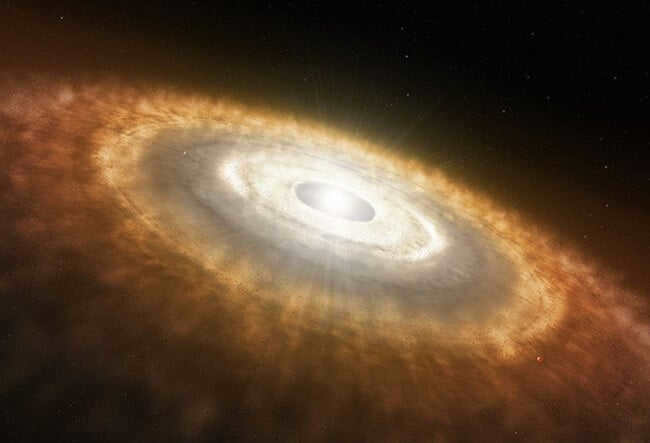
An artist’s depiction showcases the process of the early solar system. The collision of particles within the accretion disk resulted in the formation of planetesimals, eventually leading to the creation of planets.
Within the following 50 million years, the central hydrogen within the protostar experienced a significant increase in pressure and density, triggering a thermonuclear reaction. This reaction caused the temperature, pressure, and density to continue rising until reaching hydrostatic equilibrium. At this point, the Sun officially became a main-sequence star. The formation of the heliosphere through solar winds then occurred, sweeping away any remnants of the protoplanetary disk composed of gas and dust into interstellar space, marking the completion of the planetary formation process.
Origin of the nebular hypothesis
The origin of the nebular hypothesis can be traced back to the 18th century when Immanuel Kant and Pierre-Simon Laplace independently proposed similar ideas about the formation of the solar system.
Kant suggested that a rotating nebula of gas and dust could condense over time to form planets and stars. Laplace expanded on this idea by proposing that the nebula would start to contract due to its own gravity. As it contracted, the nebula would spin faster, causing it to flatten into a disk shape. Eventually, the center of the disk would become dense enough to form the Sun, while the remaining material would coalesce to form planets.
Development of the nebular hypothesis
The nebular hypothesis gained more support in the 19th century with the discovery of more evidence. Astronomers observed that many other stars were surrounded by disks of gas and dust, similar to the proposed early solar nebula. This provided further evidence that the formation of the solar system was not a unique event.
In the early 20th century, the discovery of the interstellar medium, which is a cloud of gas and dust between stars, further supported the nebular hypothesis. Scientists realized that the same processes that formed our solar system could also occur in other regions of the galaxy.
Modern understanding of the nebular hypothesis
Today, the nebular hypothesis is widely accepted as the most plausible explanation for the formation of our solar system. It provides a logical and consistent model that explains the observed properties of the Sun, planets, and other celestial bodies. While there are still unanswered questions and ongoing research in this field, the nebular hypothesis remains a fundamental concept in our understanding of the universe.
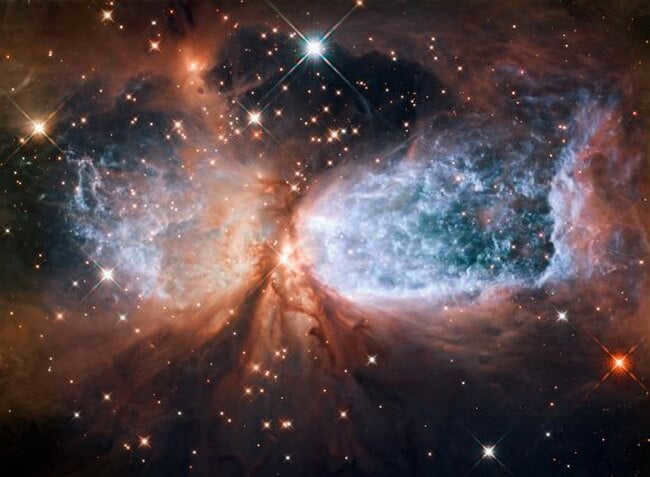
Nebula Sh 2-106. A compact star-forming region in the Swan constellation
Although Laplace’s nebular model was widely accepted in the 19th century, it had some clear inconsistencies. The primary concern was the distribution of angular momentum between the Sun and the planets, which the nebular theory failed to explain. Additionally, James Clerk Maxwell (1831-1879), a Scottish scientist, argued that the difference in rotational velocity between the outer and inner parts of the protoplanetary disk would have hindered matter accumulation. Moreover, astronomer Sir David Brewster (1781-1868) did not accept the theory, once stating:
For instance, the appearance of accretion disks around young stellar objects can be successfully explained by the preplanetary cloud model. Multiple simulations have also demonstrated that the accretion of matter within these disks results in the creation of several Earth-sized celestial bodies. Safronov’s book has provided a conclusive solution to the question of the origin of Earth-group planets (or Earth-like planets, if you prefer).
While the preplanetary cloud model was initially applied exclusively to the solar system, many theorists argue that it can serve as a universal framework for understanding the formation of exoplanets throughout the entire universe. As a result, it continues to be frequently employed in explaining the origins of the numerous exoplanets that have been discovered.
Drawbacks of the nebular hypothesis
Notwithstanding the widespread acceptance of the nebular model, it still harbors several unresolved queries that perplex even contemporary astronomers. One such concern pertains to the issue of tilt. As per the nebular theory, all planets encircling stars ought to possess identical axis inclinations in relation to the ecliptic plane. However, it is common knowledge that the inner and outer planets exhibit distinctly disparate axis inclinations.
While the planets within the inner circle exhibit axis inclination angles that span from 0 degrees, the Earth and Mars possess axis inclinations of approximately 23.4 and 25 degrees, respectively. On the other hand, the planets within the outer circle showcase distinct axis tilts. Specifically, Jupiter’s axis tilt amounts to 3.13 degrees, while Saturn and Neptune boast tilts of 26.73 and 28.32 degrees, correspondingly. Notably, Uranus displays an exceptionally extreme axis tilt of 97.77 degrees, which effectively causes one of its poles to constantly face the Sun.
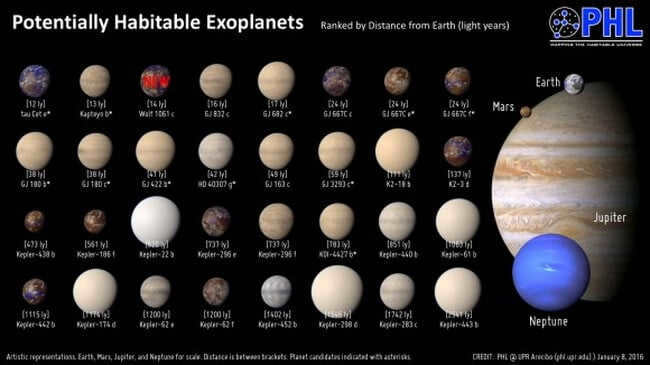
List of exoplanets with potential habitability, as determined by the Planetary Habitability Laboratory
The unanswered questions are likely the ones that are most relevant to understanding how formation occurs, which is why they are so challenging to address. Just when we believe we have found the most convincing and logical explanation, there are always aspects that remain unexplained. However, we have made significant progress in developing our current models of star and planetary formation. As we continue to learn more about nearby star systems and explore the cosmos, our models will continue to evolve and become more refined.
Throughout history, there has been a continuous quest to comprehend the origins of the world. However, the majority of theories were built upon conjecture and disputes. It was not until the 16th-18th centuries that a scientific foundation began to be sought for all explanations.
Regarding the formation of the solar system, the nebular hypothesis takes precedence. According to this hypothesis, the Sun and other celestial bodies within the system emerged from nebular matter billions of years ago.
The Formation of the Solar System According to the Nebular Hypothesis
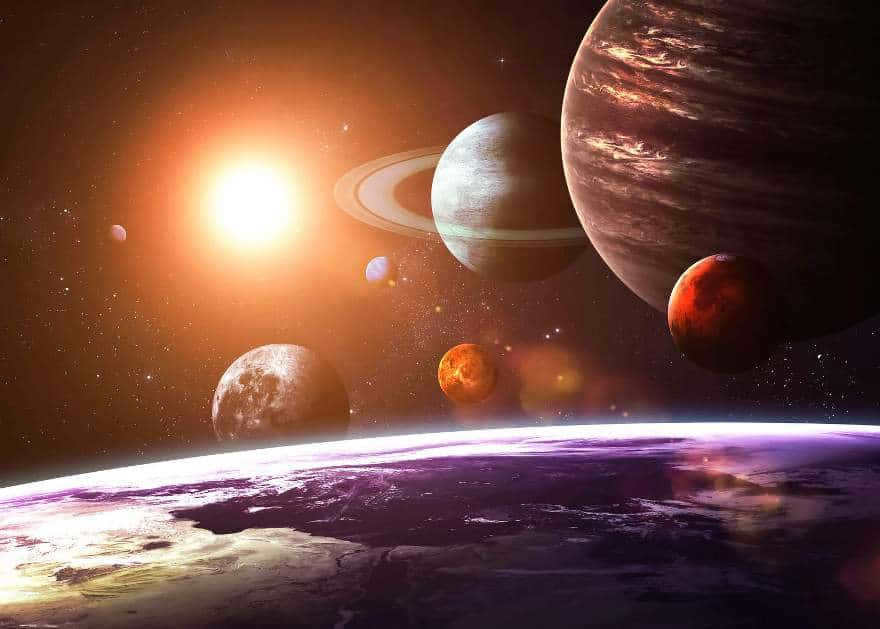
In essence, the solar system originated from a vast cluster of molecular gas and dust. However, approximately 4.57 billion years ago, an unexpected occurrence caused its collapse. This phenomenon could have been triggered by a shock wave emitted from a supernova or by a gravitational collapse within the gas and dust cloud itself.
Following this event, certain regions started to condense, giving rise to denser areas. These regions attracted more matter and began to spin, resulting in increased pressure and subsequent heating. The majority of the material accumulated in the central region, while the remaining remnants flattened out into a disk-like shape. This central mass eventually formed the Sun, while the surrounding material became the protoplanetary disk.
The dust and gas in the disk underwent a process of coalescence until they combined to form large celestial bodies – planets. The ones that formed closer to the Sun accumulated a higher concentration of metals and silicates, namely Mercury, Venus, Earth, and Mars. However, these metallic elements were present in limited quantities, resulting in the relatively small sizes of these listed planets.
Further out from Mars, in the region between Mars and Jupiter, the conditions were cold enough for volatile icy compounds to remain solid. As a result, the giant planets came into existence in this area. The icy compounds dominated, allowing them to amass more mass and attract additional hydrogen and helium. The remaining fragments of debris eventually migrated to the Kuiper belt and the Oort cloud.
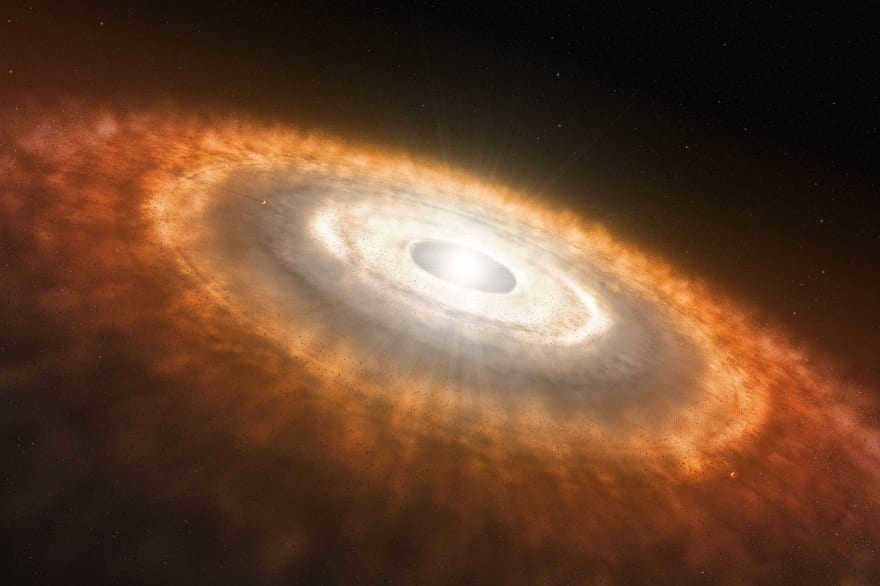

An artistic interpretation of the early solar system depicts the formation of planets resulting from the collision of particles in the accretion disk.
After a span of 50 million years, the density and pressure of hydrogen escalated to a point where fusion was initiated. The temperature, pressure, and velocity rose, allowing for hydrostatic pressure. The protoplanetary disk was cleared of dust and gas debris by the solar wind, ultimately completing the process and giving rise to the heliosphere.
Astrophysicist Sergey Popov discusses the formation of supermassive black holes, the creation of planets, and the accumulation of matter in the early Universe.
A Brief Overview of the Study of Solar System Formation
In 1734, Emanuel Swedenborg proposed a hypothesis regarding the formation of the solar system. This idea was later expanded upon by Immanuel Kant, who theorized that gas clouds gradually rotate, collapse, and condense under the force of gravity, resulting in the formation of planets and stars.
In 1796, Pierre-Simon Laplace further developed this concept on a smaller scale. He hypothesized that our Sun initially possessed a vast, hot atmosphere that expanded and contracted. As this cloud of gas and dust rotated, it shed material, which then compacted and gave rise to the formation of planets.
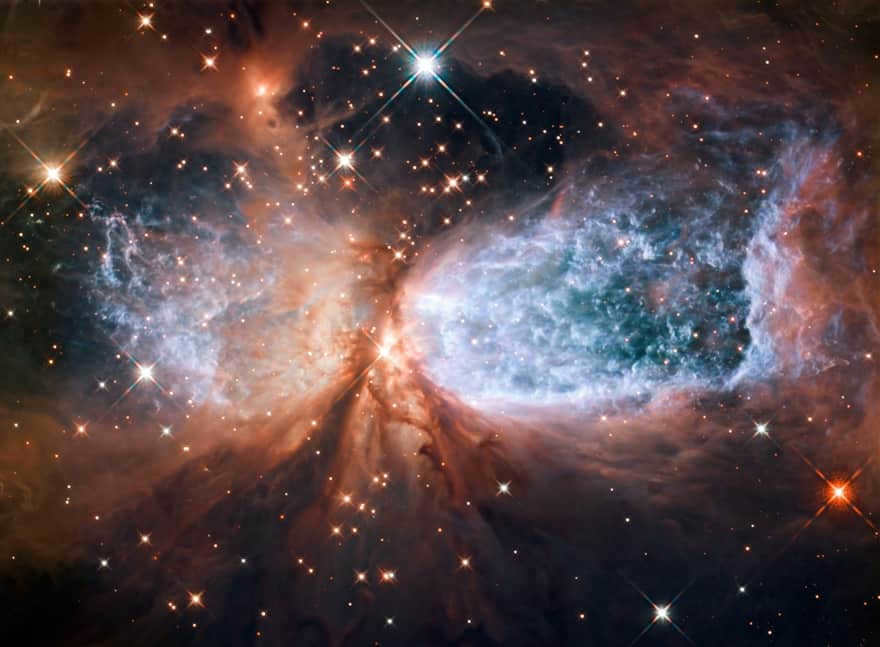
The formation of the solar system has been a topic of great interest for astronomers. However, Laplace’s model, which gained popularity in the 19th century, faced several challenges. One major issue was the distribution of angular momentum between the star and the planets. James Maxwell argued that there would be a discrepancy in rotational velocity between the outer and inner rings, hindering the condensation of material. David Brewster also opposed the model, suggesting that if this were the case, the Moon would have to contain some of Earth’s water and possess an atmosphere.
In the 20th century, the popularity of this model diminished and scientists started searching for new explanations. However, in 1970, it experienced a revival in the form of the solar nebular disk model (SNDM), developed by Viktor Safronov (1972). He addressed nearly all of the major issues in the process of planet formation and provided explanations for most of them.
For instance, the presence of accretion disks around young stars was elegantly explained by this model. Various models also demonstrated that the accretion of material results in the formation of Earth-sized bodies. Initially, this concept was only applied to our own solar system, but it was later expanded to encompass the entire Universe.
Challenges in the Study of Solar System Formation
The nebula theory, which is widely accepted as the explanation for the origin of the Sun and the solar system, still faces unresolved issues. One such problem is the inconsistency in tilted axes. According to the nebular theory, all stars should have a similar tilt relative to the ecliptic. However, we observe that the inner and outer planets have different tilts.
While the inner planets have almost no tilt (0°), Earth and Mars are tilted at 23.4° and 25° respectively. Uranus, on the other hand, is significantly tilted at 97.77°, with its poles facing the Sun.
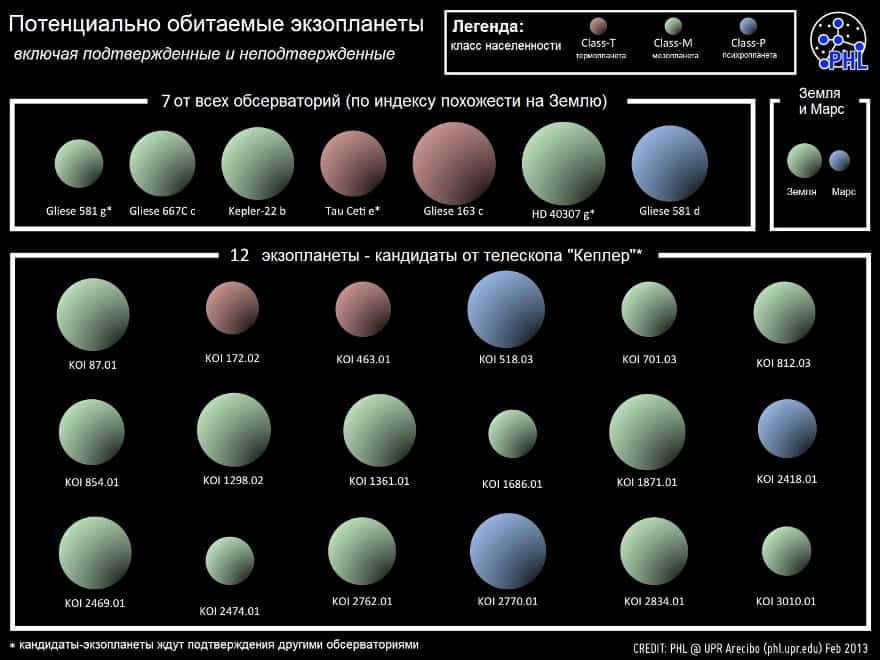
List of exoplanets with potential for habitation
The examination of exoplanets has also raised doubts. For instance, the discrepancy arises from the existence of “hot Jupiters” that orbit their stars in just a few days. Scientists have had to revise their hypotheses, but the inconsistencies persist.
Gaining a complete understanding of our origins and the past history of the solar system remains challenging. Just as it seems they have found the solution, a new complication arises. However, significant progress has been made in exploring the universe. Further investigation will help bridge the gaps.
The process of solar system formation
The composition of the solar system
Fascinating facts about the solar system
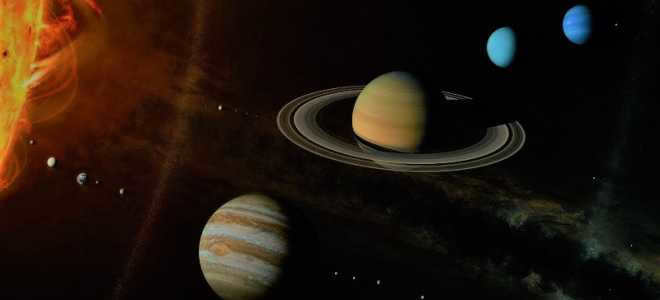
It is a well-known fact that the formation of planets is not an instantaneous event, and not every celestial body has the potential to develop into one. In reality, the creation of a planet is a result of various influencing factors. Additionally, this intricate process spans over countless millions, or even billions, of years.
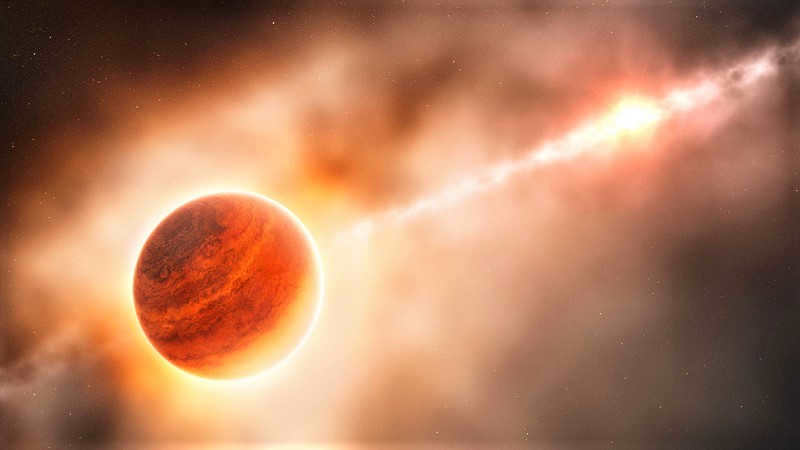
The Formation Process of the Solar System
According to current scientific theories, the birth of our solar system took place approximately 4.6 billion years ago. It is believed that this occurred through the gravitational collapse of a massive interstellar molecular cloud, resulting in the concentration of a significant amount of matter at the center of the collapse. From this concentration, our Sun, a star, was formed. Simultaneously, the remaining matter coalesced to form a protoplanetary disk that encircled the newly formed star.
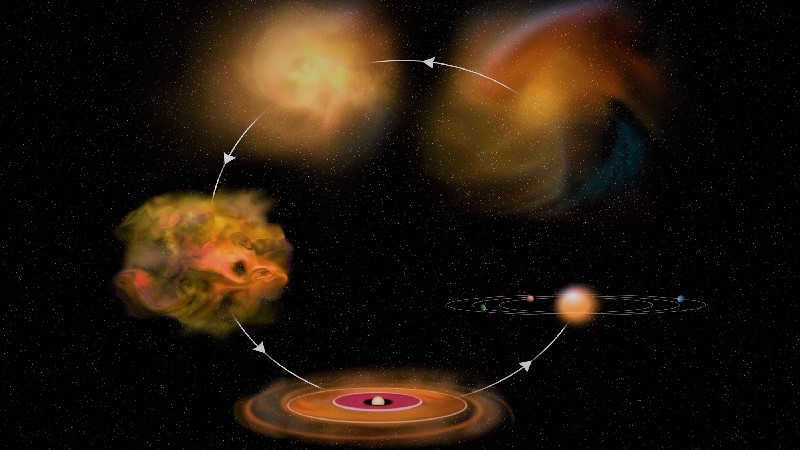
In fact, planets, satellites, asteroids, and other celestial bodies were created from this disk.
Within the solar system, a wide range of interactions are constantly taking place, from small particles to large objects. These interactions involve movement, collisions, emergence, and collapse, resulting in the formation of new entities. It can be said that the Universe is in a perpetual state of development and evolution.
One notable aspect of this development and evolution is the continuous change in the size, characteristics, boundaries, and contents of objects within the system.
The origin of planets
In the beginning, protoplanets were formed within the system, which were essentially large embryos within the protoplanetary disk. These protoplanets had already experienced internal melting, leading to the formation and separation of their interiors.
Over time, the protoplanets grew in size or, conversely, decreased in size through mergers and collisions with one another. For instance, Mercury lost a portion of its mantle during a collision with another celestial body. It is believed that the Moon itself was the result of a massive collision.
Currently, we are able to observe the outcomes of these interactions, which can be seen as confrontations between celestial objects. However, it still remains unclear how the initial orbits of protoplanets ultimately led to the creation of nearly circular planetary orbits.
Without a doubt, the Sun has had a significant impact on the formation of planets in its vicinity, shaping their fundamental attributes such as composition, size, and temperature, through its abundant energy and intense heat.
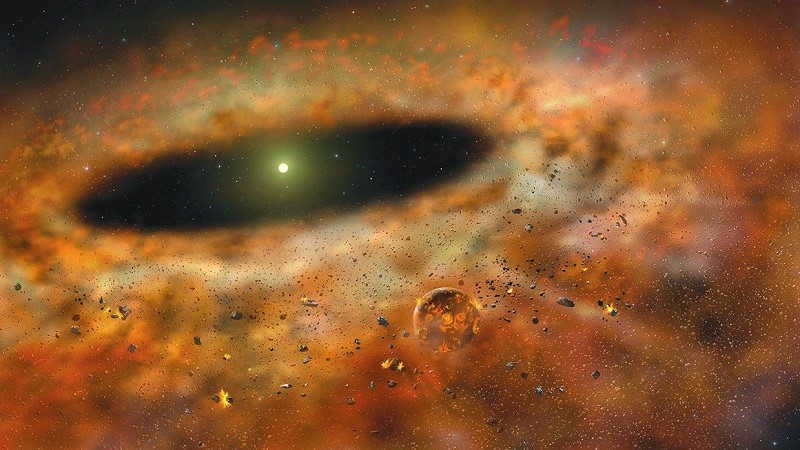
Indeed, the formation of planets commences through specific evolutionary mechanisms:
- An embryo materializes within a circumstellar gas disk that orbits in close proximity to the newly formed star;
- Through accretion, the gravitational force causes the mass of this embryo to accumulate;
- A celestial entity takes shape within the stellar orbit, drawing in gas and dust particles from the disk, which gradually becomes enriched with dense chemical constituents.
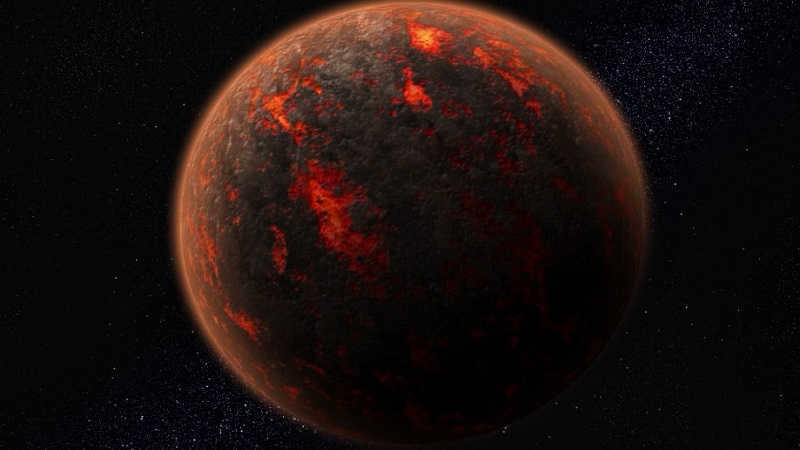
Alternative hypothesis
While there exists an alternative hypothesis regarding the origin of planets, proposing that they are formed through the collapse of an initial gas-dust cloud, there is considerable controversy surrounding this idea within the scientific community. This is primarily due to the existence of a so-called void between large planets and small stars, which suggests that they cannot be descended from their stellar counterparts.
As we are aware, stars are distinguished by their massive size, mass, and thermonuclear reactions occurring within them. If celestial bodies do not possess sufficient mass, these reactions will not take place. Consequently, it is conceivable that planets may be born from such objects, albeit under the influence of other determining factors.
Discovering all the mysteries of the cosmos would undoubtedly plunge us into an irreparable state of ennui.
Anatole France (renowned French author and literary analyst).
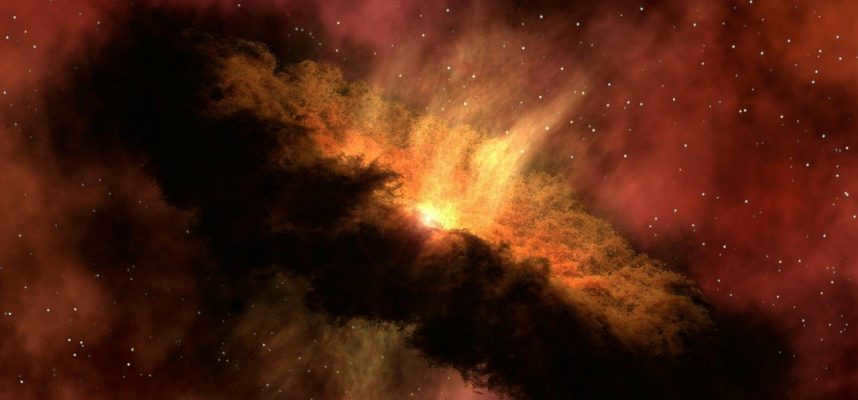

Clouds of gas and dust surrounding newly formed stars give birth to planets. Earth and the other planets in our solar system were formed billions of years ago under the perfect conditions.
Our solar system consists of the Sun, a medium-sized star, and eight planets orbiting around it. These planets can be categorized into two types. The four inner planets, which include Mercury, Venus, Earth, and Mars, are smaller in size and primarily composed of metals and rocks. On the other hand, the four outer planets – Jupiter, Saturn, Uranus, and Neptune – are larger and primarily composed of gases.
What exactly are planets? Where did they come from? Why do some of them have a solid composition while others are made mostly of gas? What characteristics define our own planet? In this article, we will endeavor to provide insights into these inquiries.
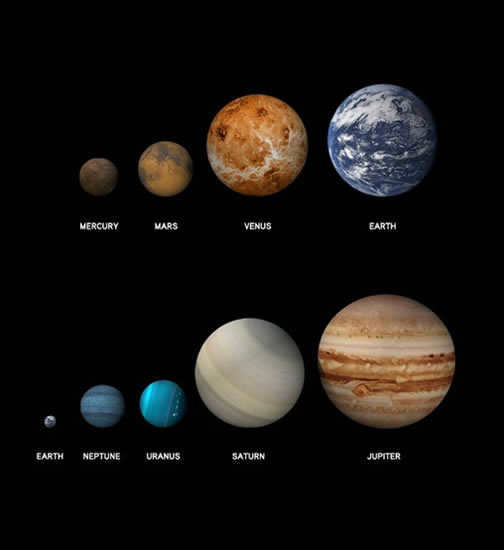
The Birth of the Sun.
Let’s explore the origins of our star. Approximately five billion years ago, a colossal cloud drifted within a spiral arm of the Milky Way galaxy. Known as a nebula in astronomical terms, this cloud consisted of dust and gas, primarily composed of hydrogen and helium, along with a small proportion of denser elements. These denser elements were created during the earlier stages of the universe when preceding stars reached the end of their lives.
The cloud / nebula initiated the process of compression, collapsing inward. During the compression, the atoms started to exert pressure on one another, resulting in the release of heat. With the accumulation of heat, the atoms engaged in more frequent and intense collisions. Ultimately, they achieved a temperature at which the protons at the cores of the atoms commenced fusion, known as nuclear fusion. Once the fusion process concluded, the minuscule amount of matter transformed into an immense quantity of energy, giving rise to a star. Thus, our sun came into existence.
The birthplace of planets.
After the Sun formed, there was still some leftover matter from the nebula that didn’t get absorbed by the star. This matter gathered together to form a flat disk of dust and gas, which was held in place by the gravitational pull of the Sun. This disk is known as an accretion disk. Over time, the material in the disk started to accumulate through a process called accretion, where particles stuck together.
Each planet in our solar system has its origins in these tiny dust particles that were present in the accretion disk. Atoms and molecules began to come together and form larger particles through a process of clumping. Through gentle collisions, some of these particles transformed into spheres and eventually grew into planetesimals, which were objects several kilometers in diameter. These planetesimals were big enough to attract other objects around them through gravitational forces.
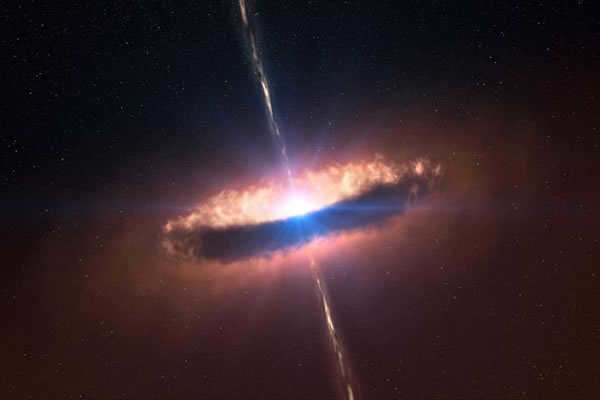
Over a prolonged duration, different worlds collided, fused, and transformed. Eventually, only eight planets remained, each having successfully cleared its orbit. A planet is characterized as a celestial body that revolves around the sun, possesses sufficient mass to maintain a spherical shape due to its own gravity, and has effectively removed smaller objects from its vicinity.
In 2007, scientists at the University of California, Davis deduced that our solar system reached its complete formation approximately 4.568 billion years ago. This conclusion was reached by determining the age of rocky substances found within the asteroid belt.
The sun released a continuous flow of energy and particles known as the stellar wind. This powerful wind was responsible for stripping away most of the gases from the four planets nearest to the Sun, resulting in their smaller size and leaving behind only rocks and metals. As a result, these planets are referred to as rocky planets or Earth-group planets. On the other hand, the four outer planets were located at such a distance from the Sun that the solar wind was unable to remove their ice and gases. Consequently, these planets retained their gaseous composition, with a small rocky core.
The outer planets originally formed from a larger amount of gas, specifically hydrogen and helium, compared to the other planets. This was due to the Sun’s gravitational pull, which caused the heavier materials in the original solar disk to be drawn closer.
Between the inner and outer planets lies a region brimming with millions of asteroids – minute rocky, icy, and metallic entities remaining from the creation of the solar system. No planets have taken shape in this area. Scientists propose that the influence of Jupiter’s gravity on this region was so potent that it hindered the formation of any other planets. Jupiter boasts a diameter that is 11 times larger than Earth’s and is more than twice the size of all the other planets combined.
Out of the four rocky planets, Mercury is the tiniest, measuring roughly two-fifths the size of Earth. Earth and Venus are nearly identical in size, while Mars is about half the size. Astronomers theorize that a smaller object collided with Mercury, causing the vaporization of its crust and leaving behind an iron core that is larger than usual.
Earth’s Unique Conditions
During the formation of the rocky planets, they primarily consisted of molten rock. Over millions of years, they gradually cooled down. In the case of Mercury and Mars, which are smaller in size, they hardened and became solid.
However, Earth and possibly Venus maintained a distinct state of conditions. Earth remains partially molten, with a solid rock crust and an intermittently solid mantle. At its core, Earth has a swirling, solid iron core immersed in hot liquid known as magma.
Some scientists refer to these conditions as the “Goldilocks conditions” because they are just right for life on Earth. The planet is not too hot or too cold, not too large or too small, and positioned at just the right distance from the Sun.
The closest celestial body to us is the Moon. Unlike the planets, the Moon orbits around the Earth rather than the Sun. It is a rocky object that is approximately a quarter of the size of our planet. The origin of the Moon has long been a subject of intrigue, but thanks to the Apollo missions in 1969, we have gained valuable knowledge about it through the collection of rock and soil samples.
According to the prevailing theory, a small planet, roughly one-tenth the size of Earth, collided with our planet approximately 4.45 billion years ago. At that time, the Earth was still in its early stages of formation, with a possibly thin crust and a scorching hot interior. Some of the material from this collision merged with the Earth, while the rest was ejected into space and eventually coalesced to form the Moon. Initially, the Moon was much closer to Earth, but it has been gradually moving away at a rate of nearly four centimeters per year.
The Earth is greatly impacted by the Moon, resulting in various effects. The Moon’s gravitational pull leads to the creation of tides in the Earth’s oceans, while also influencing the Earth’s wobble, thereby contributing to the stabilization of the climate. Additionally, the Moon’s presence has caused a slowdown in the Earth’s rotation, as it now takes 24 hours for the Earth to complete one revolution on its axis, as opposed to the previous duration of 12 hours.
Pluto and beyond.
Up until 2006, it was widely accepted that there were a total of nine planets in our solar system, but that number was reduced to eight when the International Astronomical Union made the decision to reclassify Pluto.
Pluto, which used to be considered the ninth planet, is now classified as a dwarf planet or planetesimal. This decision was made because Pluto is significantly smaller than the Moon and lacks the ability to clear its own neighborhood in space. Despite occasionally being closer to the Sun than Neptune, Pluto orbits far behind Neptune in the asteroid belt.

Astronomers have a high level of confidence in the theory that our solar system was formed through a process known as accretion. This confidence stems from the observation of a similar phenomenon taking place in the Orion Nebula. Located 1,500 light-years away from Earth, the planet-forming region in the Orion Nebula is situated on the near side of a massive cloud that dominates the constellation Orion. Since 1993, astronomers have discovered the formation of several hundred stars in this region, with many of them surrounded by rings of dust in accretion disks, much like the one that led to the creation of our own solar system. The presence of dust and gas clouds around these new stars in the Orion Nebula suggests the potential for the development of planetary systems similar to our own.
In 1995, astronomers in Switzerland made a groundbreaking discovery when they detected the presence of an exoplanet, a planet that exists outside of our own solar system, orbiting a typical star. These exoplanets are typically much larger than Earth, often comparable in size to Jupiter, which makes them easier to observe and measure from hundreds of light-years away. Instead of directly observing these planets, astronomers use indirect methods to detect them, such as measuring the gravitational influence they have on their parent star or observing the changes in brightness as the planet transits in front of the star.
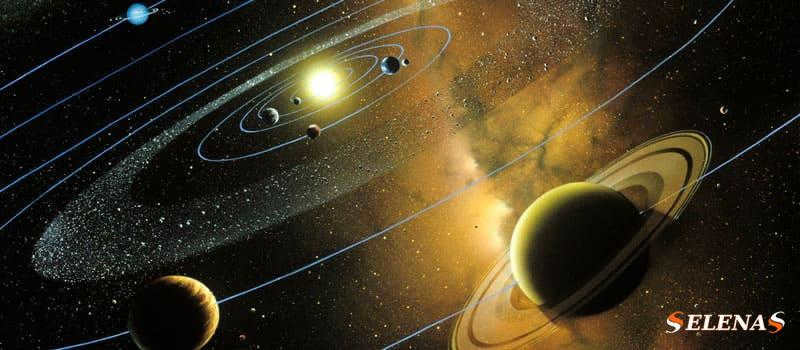
Today, I want to talk about the formation of our solar system and its unique characteristics.
As the third planet from the Sun, Earth plays a crucial role in understanding the origins of our solar system.
Our curiosity about our origins sets us apart from others, prompting us to explore the mysteries of our existence.
Unfortunately, this curiosity sometimes leads us astray, as we mistakenly believe our significance surpasses reality.
The history of our exploration into the formation of our solar system is filled with false starts, and astronomers continue to refine our understanding.
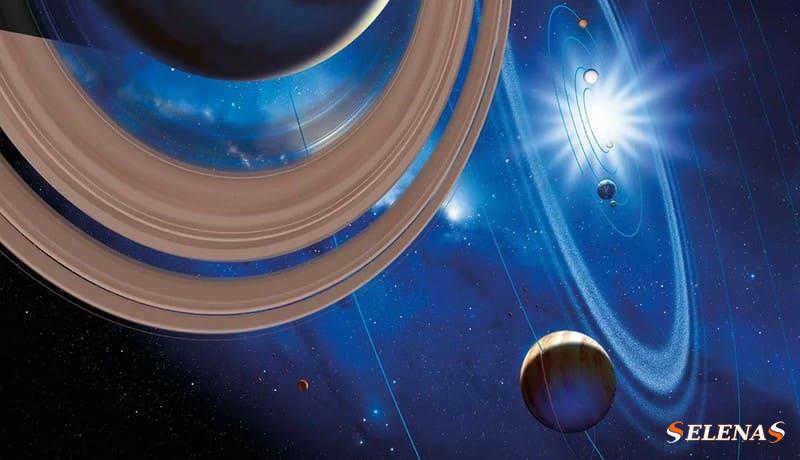
The initial belief of the greatest intellectuals in the world was that the Earth was the focal point of creation, with the Sun, Moon, planets, and stars orbiting around us.
This concept persisted for over a millennium, starting from the time of Aristotle and ancient Greece.
It was not until the 16th century when Polish astronomer and mathematician Nicolaus Copernicus challenged this notion that the prevailing opinion began to shift.
Copernicus posited that the planets, including Earth, orbit around a central sun.
Copernicus’ groundbreaking discovery
If we were still under the notion that everything in the universe revolves around the Earth, it would be difficult for astronomers to form their current understanding of our solar system’s origins.
Copernicus’ remarkable breakthrough is rightfully regarded as one of the most significant scientific revolutions in history.
However, his inspiration did not stem from astronomical observations, but rather from the elegance of mathematics.
The ancient concept of geocentrism, which proposed that all celestial bodies orbit the Earth in perfect circles, encountered challenges when observing the night sky.
Some of the planets appeared to be deviating from their expected paths – a behavior that contradicted the notion of them revolving around the Earth.
To reconcile this discrepancy, the ancient Greek polymath Ptolemy introduced the concept of “epicycles,” which posited that the planets moved in smaller circles, which in turn revolved around the Earth.
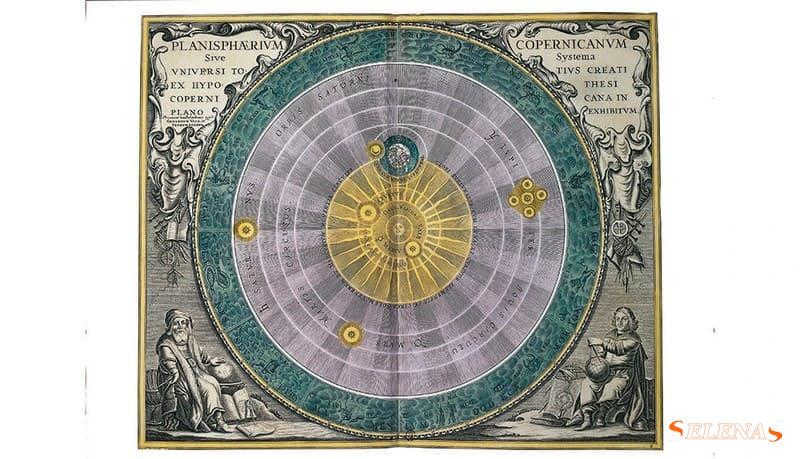
However, a significant breakthrough occurred in order to align our belief that the Earth was at the center of the universe with what we observed in the night sky.
Copernicus’s brilliance lay in his recognition that placing the Sun at the center would eliminate the need for complicated epicycles.
According to his heliocentric model, Mars appears to have its own rotation because the Earth is surpassing it in its orbit around the Sun.
Due to his fear of negative backlash from religious circles, Copernicus chose to delay the publication of his work until after his death.
Legend has it that he only laid eyes on a copy of his original work on his deathbed.

During the 16th century, Nicolaus Copernicus questioned the prevalent belief that the Earth occupied the central position in the universe.
Exploring Galileo’s Findings
It took several decades for empirical evidence to validate the concept of a “solar system.”
The work of Italian astronomer Galileo Galilei in the early 1600s played a significant role in solidifying this notion.
Naturally, the process was not straightforward.
As we are aware, Galileo encountered opposition from the church and did not receive official forgiveness until 1992.
However, from a scientific perspective, the turning point occurred when he observed Venus exhibiting phases of waxing and waning, similar to the moon.
This would be impossible if both Venus and the Sun orbited the Earth; it would only be feasible if both planets revolved around a central source of light.
Therefore, we have claimed our position as one of the planets belonging to the Sun’s celestial family.
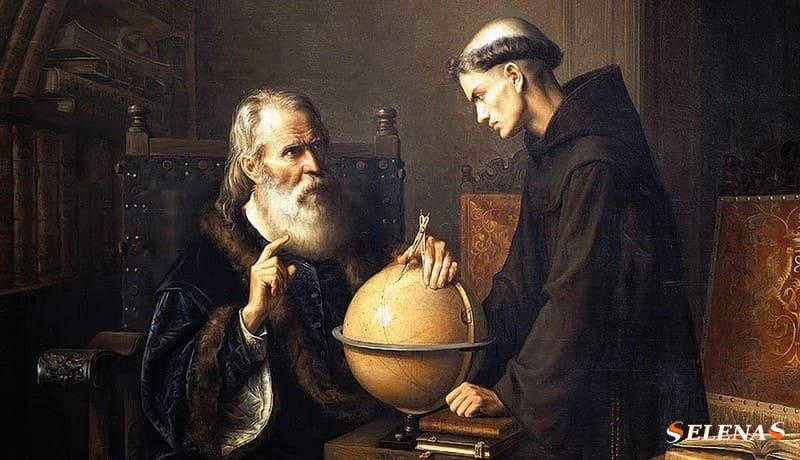
Galileo Galilei, portrayed in this artwork by Felix Parra, is seen explaining his astronomical theories to a monk at the University of Padua.
Subsequently, attention naturally shifted to the process behind the formation of such a system.
In the 1630s, the French philosopher René Descartes was among the first to contemplate this.
His starting point was the concept that nothing in nature can be void.
Therefore, if a particle in space were to change its position, another particle would have to move to fill the void, resulting in a series of “vortices”.
Descartes believed that planets were formed when material trapped within these spinning circles somehow condensed.
It was Sir Isaac Newton and his renowned work on gravity that provided an explanation for why the planets orbit around the Sun.
However, this explanation did not address the origins of the Sun and its planets.
Different theories on the origin of the solar system
In the mid-1700s, French mathematician Georges-Louis Leclerc proposed that the planets formed as a result of a comet colliding with the Sun, causing a massive ejection of matter outward.
Over time, according to Leclerc, gravity brought this matter together, leading to the formation of orbiting worlds.
By the end of the century, Leclerc’s fellow countryman Pierre-Simon Laplace disproved this theory, demonstrating that any ejected material would be pulled back by the gravity of the Sun.
Laplace himself then began to develop an alternative explanation.
The nebulae were given the name nebulae, which is derived from the Latin word “clouds”.
Laplace put forward the hypothesis that the Sun originated from one of these clouds.
As the cloud collapsed due to gravity, it began to rotate faster and faster, similar to how a figure skater spins on ice.
According to Laplace’s theory, as the Sun’s rotation increased, matter was ejected from its surface, forming a flat disk around the star.
Planets then formed as this material came together under the influence of gravity.
However, at the beginning of the 20th century, Laplace’s idea was nearly abandoned.
The main issue was that if this model was accurate, the Sun would be spinning much faster than it actually does, and the planets would be rotating at a much slower pace.
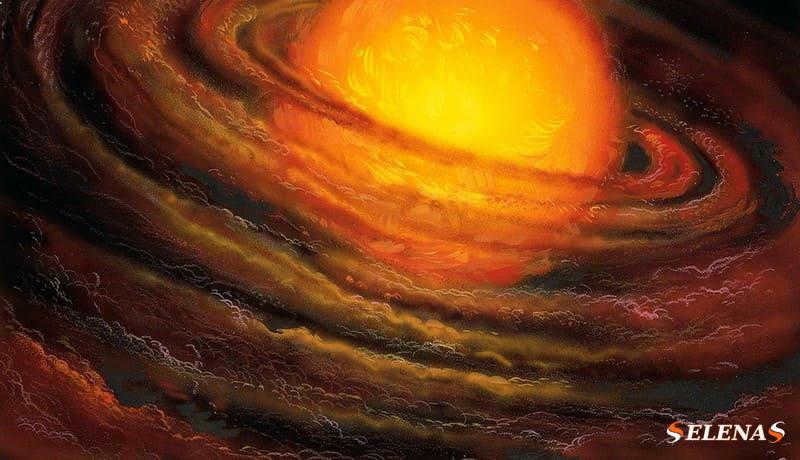
Astronomers like Sir James Jeans, faced with the challenge of explaining this phenomenon, sought out an alternative solution.
In 1917, Jeans proposed the idea that the formation of the solar system involved the presence of another star.
If this star had passed close to the Sun, its powerful gravitational force would have torn away a significant amount of stellar matter.
According to Jeans, this material would have served as the necessary building blocks for the creation of planets.
However, this theory did not stand the test of time.
By 1929, it had been proven that such a close encounter was highly unlikely due to the vast expanse of space.
In addition, even if it had occurred, the Sun would have absorbed most of the displaced material.
As time went on and no definitive leader emerged, fresh theories continued to surface.
During the 1940s, Fred Hoyle, a British astronomer, put forth the idea that the Sun had once been accompanied by a significantly larger companion star that eventually exploded as a supernova.
As a result of this explosion, some fragments became trapped in the gravitational pull of the Sun and gradually merged together to form planets.
However, this theory faced criticism, in part because it struggled to explain the relatively small masses of Mercury and Mars.

In the 1970s, astronomers revisited Laplace’s nebulae theory, which shed new light on the formation of the Sun. The main challenge with this theory was that the Sun’s observed rotation was slower than expected. However, it was proposed that the drag caused by dust particles in the surrounding cloud could explain this discrepancy by slowing down the Sun’s rotation.
This hypothesis gained significant support in the early 1980s when astronomers discovered protoplanetary disks, also known as “propliders,” around young stars. These dusty, flat disks of matter provided further evidence for the formation of planets in other parts of the universe.
Exploring Extraterrestrial Solar Systems
Studying other solar systems is crucial in our quest to comprehend the origins of our own.
However, it wasn’t until the mid-1990s that astronomers made the groundbreaking observation of a planet orbiting a star similar to our Sun.
This groundbreaking discovery occurred in 1995 when a world was found circling the star 51 Pegasus.
Since then, astronomers have uncovered over 3,000 exoplanets in alien solar systems over the past twenty years.
However, it became evident from the beginning that these extraterrestrial communities were not mere replicas of our own.
For instance, the exoplanet 51 Pegasus, now called Dimidium, completes one orbit around 51 Pegasus in just over four days.
It is nearly eight times closer to its star than Mercury is to the Sun.
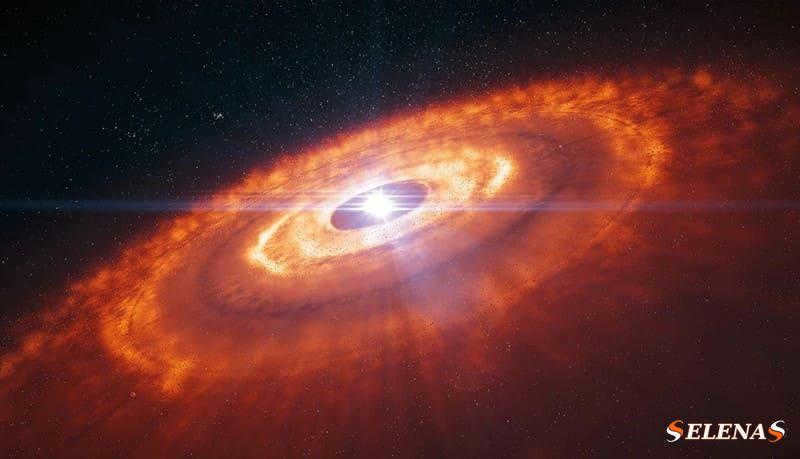
The young star is surrounded by a structure made up of dust and gas called a “protoplanetary disk” in which new planets are formed.
Underneath the simple image of planets forming from the remains of a newborn star, it is extremely challenging to imagine such a massive world being created in such close proximity to its parent star.
A more plausible explanation is that the planet initially formed at a much greater distance from the star and then gradually moved closer over time.
This provided compelling evidence that planetary orbits are not fixed, but can vary significantly.
Encouraged by these discoveries, astronomers began to examine our own solar system with a fresh perspective.
In 2005, a decade after Dimidius’ discovery, a team of astronomers put forward the Nice model (named after the city of Nice, France, where it was first proposed).
The concept behind this notion is that the colossal planets in our solar system – Jupiter, Saturn, Uranus, and Neptune – were initially in much closer proximity.
Over time, Jupiter shifted its position closer to the Sun, while the remaining three planets moved further away.
In certain scenarios, Uranus and Neptune even exchanged positions.
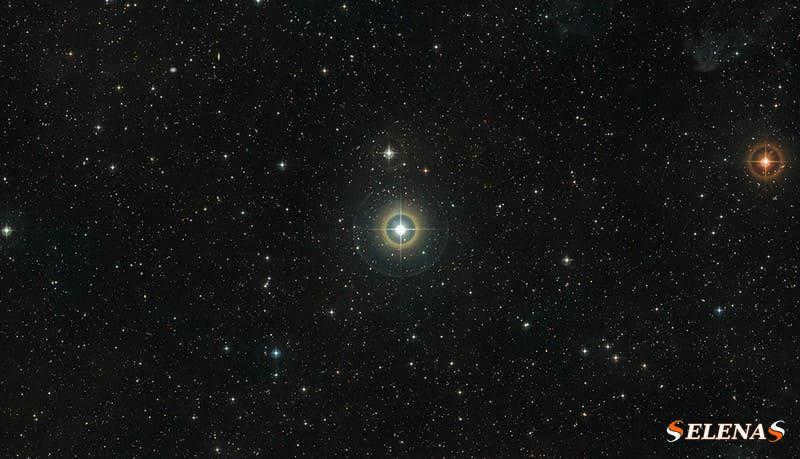
Stars like 51 Pegasus, despite their vast distance from Earth, provide valuable insights into the formation of our solar system.
If Jupiter were to move towards the Sun, it would scatter numerous smaller objects, much like a dog running through a crowd of pigeons.
A significant number of these displaced objects would eventually find their way into the solar system, resulting in a dramatic increase in the number of meteors bombarding the rocky planets and their moons.
Indeed, there is evidence of a marked increase in impact activity on the Moon between 3.8 and 4.1 billion years ago (any evidence of such impacts on Earth would have long since vanished).
Neptune’s motion moving away from the Sun also caused smaller objects to move further away, which may help explain the presence of the Kuiper belt and the scattered disk, two collections of smaller objects in the outer regions of our solar system.
Nibiru, the mysterious planet in our solar system
However, while this was a significant advancement, the original Nice model had its limitations.
By using computer simulations to recreate the gravitational interactions between the four giant planets, scientists were able to generate a solar system that resembled ours only 3 percent of the time.
But by making a small adjustment, they were able to increase that percentage to 23 percent.
They accomplished this by introducing a fifth giant planet.
However, we have only observed four giant planets so far.
So, if we take this explanation seriously, we should be able to determine the fate of this other planet.
The concept of rogue planets, which astronomers have already discovered multiple instances of, is by no means preposterous.
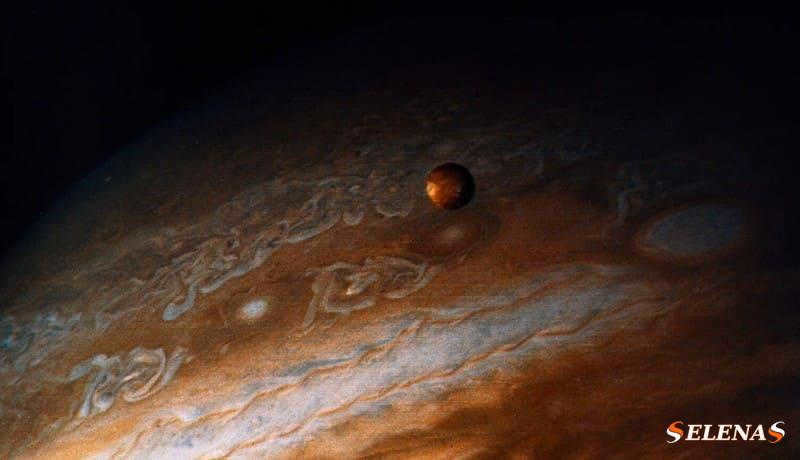
The Nice solar system model is founded on the presence of a fifth wandering planet similar to Jupiter (as observed by Voyager 2).
However, an alternative and more intriguing theory suggests that this fifth massive planet is still present within our own solar system, patiently awaiting our discovery.
The excitement surrounding this potential celestial body, known as the “Ninth Planet” or “Nibiru,” has become one of the most captivating developments in the field of astronomy in recent times.
Initially, in 2014, a team of astronomers noticed the striking similarity in the orbits of multiple small objects orbiting the Sun beyond Neptune.
Then, in January 2016, it was announced that additional objects displaying the same orbital behavior had been identified.
The probability of random occurrence of such common characteristics is estimated to be a mere 0.007%.
The primary explanation posits the existence of an additional planet, at least ten times more massive than Earth, lurking in the shadows and aligning small celestial objects by exerting its gravitational force upon them.
If the hypothetical “Ninth Planet” is indeed real, the reason it has eluded our detection thus far is due to its apparent distance from the Sun.
Its orbit takes it approximately 1,200 times farther from the Sun than Earth’s orbit, making it likely to appear at least 600 times fainter than the dwarf planet Pluto.
Without precise knowledge of its location, it would be easy to overlook.
Dedicated searches are currently underway to locate its whereabouts.
These recent astronomical endeavors remind us that the narrative of our solar system’s formation is an ongoing process.
We have made significant progress since ancient Greece, but there are still many chapters left to write.
The birth of our solar system: a timeline of discoveries
Nicolaus Copernicus (1473-1543).
Hailing from Poland, Copernicus was involved in various intellectual fields, including economics, politics, and medicine. However, he is primarily remembered for his groundbreaking research on planetary orbits.
1543 – Copernicus releases De Revolutionibus Orbium Coelestium (On the Revolutions of the Celestial Spheres), presenting his revolutionary heliocentric ideas.
This publication stands as one of the most significant books in history.
Unfortunately, Copernicus only gets to see the printed text on his deathbed.

Galileo Galilei (1564-1642) is often regarded as the progenitor of contemporary astronomy. He became famous for being the first individual to utilize a telescope effectively for observing celestial phenomena, fundamentally transforming our understanding of our position in the universe.

Pierre-Simon Laplace (1749-1827) – Unsatisfied with his significant contributions to the understanding of star formation, this influential French scientist was among the pioneers in formulating the notion of black holes – celestial bodies possessing such immense gravitational force that nothing can evade their pull.
In 1796, Laplace presents his nebula hypothesis regarding the genesis of the solar system, a theory that astronomers would revisit over 150 years later.
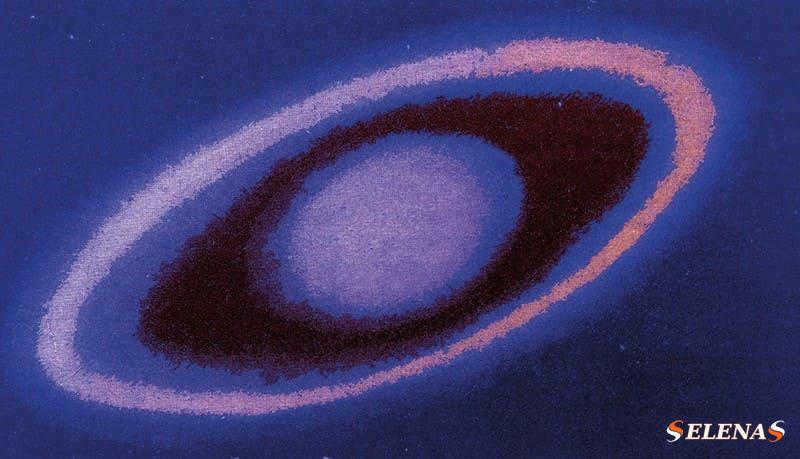

Sir James Jeans (1877-1946) was a British astronomer who became famous for his contribution to the field by introducing the concept of the “Jeans mass.”
When a nebula reaches this critical point, it goes through an irreversible gravitational compression process, leading to the formation of stars.
In 1995, astronomers made a groundbreaking discovery of the first planet orbiting a star similar to our Sun, marking the beginning of a new era in exoplanet astronomy, which has resulted in the identification of over 3,000 new worlds.
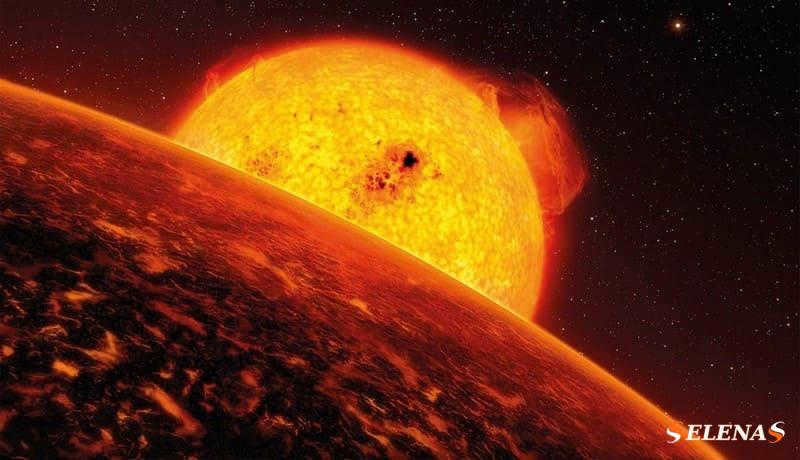
In 2005, the initial version of the Nice model is released, providing the most comprehensive explanation so far of the formation of our solar system.
This model incorporates the concept of planetary migration.
